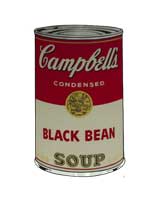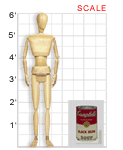VAM galleries including this work: Clara M. Eagle Gallery, Murray State University
Seeing Red | What’s the Point? | Art Through Time || VAM Home
Andy Warhol (American, 1928-1987)
CAMPBELL’S SOUP CAN, c. 1960
Serigraph; 23" X 25"
75.1.78
Clara M. Eagle Gallery, Murray State University
This Campbell’s Soup Can silkscreen print was created by artist Andy Warhol in the early 1960s. Many Americans are familiar with the art and subject of Warhol’s soup cans, which were a phenomenon and an influential factor of the Pop Art movement in the United States. His power to create works with lasting impressions and his ability to blur the boundaries between high and low art are what made Andy Warhol arguably the most influential artist of the Pop movement.
About the Artist
Andy Warhol was born in Pittsburgh, Pennsylvania, in 1928. After receiving a BFA from the Carnegie Institute of Technology (now Carnegie Mellon University) in Pittsburgh, Warhol moved to New York, where he soon achieved success as a commercial artist, with illustrations published in magazines such as Glamour, Harper’s Bazaar, Vogue, and The New Yorker. Warhol’s work, which was well received by critics and public alike, earned accolades from the Art Director’s Club and the American Institute of Graphic Arts. He had his first show, prosaically entitled “Fifteen Drawings Based on the Writings of Truman Capote,” at the Hugo Gallery in New York in 1952.
Warhol’s career as an artist really took off in the 1960s, when he began making art that focused on everyday images from popular culture. It was during this decade that he created the Campbell’s soup can images and other works that would become icons of 20th-century art. In addition to prints, Warhol created a number of 16mm films during this time; they are still shown at the Andy Warhol Museum in Pittsburgh.
In the 1970s, Warhol turned his attention primarily to painting and writing, publishing both Interview magazine and an autobiography, The Philosophy of Andy Warhol (from A to B and Back Again). In the 1980s, he created two cable television shows, Andy Warhol’s TV and Andy Warhol’s Fifteen Minutes. The artist died from complications during gallbladder surgery in February of 1987.
Classroom Ideas
Discussion: Is this print fine art? Why or why not? Does this image convey a message to or about its audience? Why do you think Warhol was able to achieve such popularity creating images of such mundane objects?
Activity: Choose an everyday item from your home that you think represents contemporary culture and create a painting of it in Pop art style.
Links
Both the Warholstars site and the Artchive include musings on the origin and motivation for Warhol’s soup cans.
[www.warholstars.org/art/warhol/soup.html]
[www.artchive.com/artchive/W/warhol.html]
The Andy Warhol Museum offers extensive information about the artist, including lesson plans and other educational resources.
[www.warhol.org/education/resources_lessons.html]
Hear an interview with Warhol, in which he describes his work, process, and more, at the BBC web site.
[www.bbc.co.uk/bbcfour/audiointerviews/profilepages/warhola1.shtml]
Pick up some interesting facts about Andy Warhol at the Artelino site.
[www.artelino.com/articles/andy_warhol.asp]
Read Andy Warhol quotes on the Quotations Page.
[www.quotationspage.com/quotes/Andy_Warhol/]
For a comprehensive guide to Warhol resources online, look him up in the Artcyclopedia.
[www.artcyclopedia.com/artists/warhol_andy.html]
Learn about printmaking, step by step, at the Museum of Modern Art’s What Is a Print? site.
[www.moma.org/exhibitions/2001/whatisaprint/print.html

